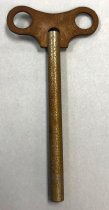Search Term Record
Metadata
Name |
Japan |
Number of Archive records |
8 |
Number of Object records |
78 |
Number of Photo records |
3 |
Number of Library records |
6 |
Related Records
-
Bag, Shopping
Koto (Japanese Harp) Strings Envelope, c. mid 1950s. Rectangular cream-colored paper, marked with red Japanese inscriptions and symbols on one side: a red Japanese fan with inscriptions on the middle and both sides, two lines of vertical Japanese writing bellow it and a red symbol that looks like a pear with three symbols inside of it.
Record Type: Archive
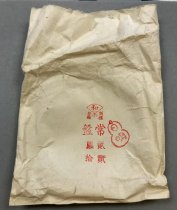
-
Receipt
Koto (Japanese Harp) String Receipt, c. mid-1950s. Paper with Japanese text printed in blue and red ink. 5.5" x 3.5"
Record Type: Archive
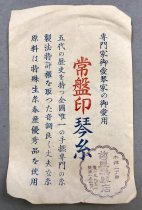
-
Chinese Bowl with Tray & Lid - Bowl, Serving
Chinese Bowl with Tray & Lid. Low round bowl (A) made of plastic to look like lacquer. Gold on rim and outside, black on inside and bottom. Rim of bowl has 5 overlapping petals to look like a (lotus?) flower. Slightly tapered sides to the bottom. Bottom meets sides at a right angle. Sides are ribbed on the outside. Bottom has a small foot. Bottom has a small diamond-shaped sticker with a scalloped edge in gold with a black border and black letter...
Record Type: Object
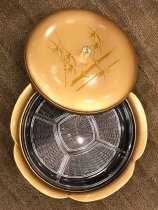
-
Flower Design Sketchbook, 1943-1944 - Sketchbook
Sketchbook belonging to Yoshiko Yamanouchi. Small spiral-bound sketchbook with 54 ruled leaves and brown cover, hand-numbered in red per illustration (not per page), beginning on the reverse side of leaf 8 as page 1, until page 62. Reads right to left. Pages are filled with sketches by Yamanouchi of floral arrangements in pencil, ink, and watercolor, with notes in Japanese and dates in English - earliest is November 19th, 1943 (on page numbered a...
Record Type: Archive
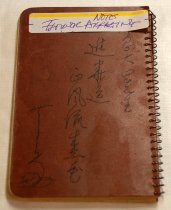
-
Formal Dress of Yoshiko Yamanouchi, c. early 1950s - Dress
Formal Dress Worn by Yoshiko Yamanouchi, early 1950s. Salmon-colored dress, made of silk. Shear neckline with orchid motif at bottom edge, front and back, short sleeves. Side zip and back button closures. Silk satin lining. Floor length skirt and short sleeves. Faux-wrap construction, gathered at proper left of waist with false tie and front draping panel. Thread loops for belt on either side.
Record Type: Object
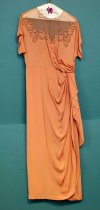
-
Invasion Money, c. 1944 - Money, Paper
Invasion Money, c. 1944. Rectangular, cream-colored paper, with writing in green, red and black. it has the number 1 in the center and four corners on both sides. The bill is outlined with green intricate web-like motif as is the number on the center (which has green motif on one side and red motif on the other). The bill has handwritten notes on two corners and bottom. According to research, the bill is a Japanese government-issued currency in t...
Record Type: Archive
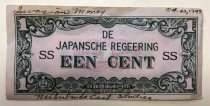
-
Japan: An Illustrated Travel Guide- Where to Go, What to Do, What to See - Lane Book Company
Japan: An Illustrated Travel Guide- Where to Go, What to Do, What to See by Lane Book Co.,1964. This book is a comprehensive travel guide on Japan, its culture, customs, sightings, things to do, and events to take part in. Includes: a foreword page, contents, information on Japan, the people, its customs, garedns, Tokyo, areas outside of Tokyo, Kyoto, areas outside of Kyoto, Hiroshima, other islands, a calender of events, and an index.
Record Type: Library
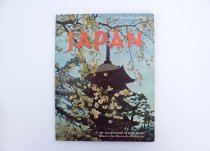
-
Japanese Calligraphy Brush, c. 1941-1945 - Brush, Calligraphic
Japanese Calligraphy Brush, c. 1941-1945. One of two cylindrical bamboo paint brush that has a hollow handle. Handle has rectangular sticker with Japanese characters and background design and a circular paper sticker with Japanese characters. The top of brush has animal hair as paint brush bristles.
Record Type: Object

-
Japanese Calligraphy Brush, c. 1941-1945 - Brush, Calligraphic
Japanese Calligraphy Brush, c. 1941-1945. One of two cylindrical bamboo paint brush that has a hollow handle. Handle has rectangular sticker with Japanese characters and background design and a circular paper sticker with Japanese characters. The top of brush has animal hair as paint brush bristles.
Record Type: Object

-
Japanese Consul General Visits San Mateo, February 1963 - Negative
Japanese Consul General Visits San Mateo, February 1963. Black and white negative of Japanese Consul General Toshio Yamanaka (far right) with San Mateo City Council members in San Mateo, California. Five council members, including four men and one woman, stand in a room while one member presents the Consul General with a document (likely a certificate or award). At bottom left in the image is a table with a teacup and plates of food. Part of a se...
Record Type: Photo
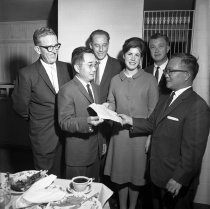
-
Japanese Data Plate, August 1941 - Tag, Identification
Japanese Data Plate, August 1941. The small rectangular label has five lines of Japanese text along with numbers printed and stamped into the metal. The four corners seems to have had holes at each corner but the corners have been broken off. Two circles with a stamped Japanese character are at each of the two bottom corners.
Record Type: Object
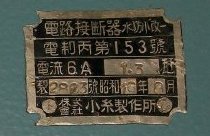
-
Japanese Data Plate, c. 1941-1945 - Tag, Identification
Japanese Data Plate, c. 1941-1945. The short but wide metal rectangular label has five lines of Japanese text printed onto plate. The four corners seems to have had holes at each corner but the corners have been broken off.
Record Type: Object
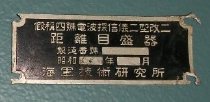
-
Japanese Data Plate, June 1944 - Tag, Identification
Japanese Data Plate, June 1944. The large rectangular Japanese metal label has eight lines of Japanese text along with numbers printed and stamped into the metal. The four corners seems to have had holes at each corner but the corners have been broken off. Two circles with a stamped anchor are at each of the two bottom corners, which indicates the plate is from the Imperial Navy.
Record Type: Object
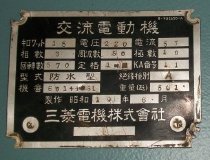
-
Japanese Girls Day Doll, c. 1920s - Doll, Decorative
Japanese Girls Day Doll, c. 1920s. Small Japanese figurine used in celebration of Girls's Day. The head, facial features, and hands are painted very pale fleshtones. Black fiber used for hair, may be dyed wool. Hair is styled with a bowl-haircut and two short side-locks. Figure wears a robe (kimono) woven in large floral pattern brocade in taupe, gold and teal, with 3 inch long stuffed sleeves, with teal lining. Portions of a red, silver an...
Record Type: Object
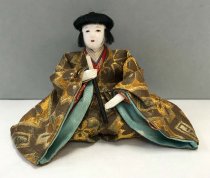
-
Japanese Girls Day Doll, c. 1920s - Doll, Decorative
Japanese Girls Day Doll, c. 1920s. Small Japanese figurine used in celebration of Girls's Day. The head, facial features, and hands are painted very pale fleshtones. Black fiber used for hair, may be dyed wool. Hair is styled with two side-locks and bangs, on a shaved head. The side-locks are tied with white thread, possibly silk. Figure wears a brocade robe (kimono) with stuffed sleeves in red, silver and orange, with a skirt in taupe, te...
Record Type: Object
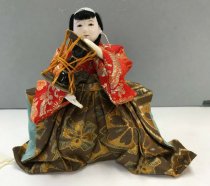
-
Japanese Girls Day Doll, c. 1920s - Doll, Decorative
Japanese Girls Day Doll, c. 1920s. Small Japanese figurine used in celebration of Girls's Day. The head, facial features, and hands are painted very pale fleshtones. Black fiber used for hair, may be dyed wool. Hair is shoulder-length (1.5 inches) and loose, with bangs. Figure wears a brocade robe (kimono) with stuffed sleeves in red, silver and orange, with a skirt in taupe, teal and gold. Skirt is gathered and a bright teal lining is rev...
Record Type: Object
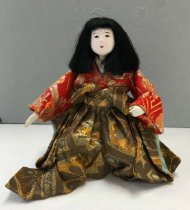
-
Japanese Girls Day Doll, c. 1920s - Doll, Decorative
Japanese Girls Day Doll, c. 1920s. Small Japanese figurine used in celebration of Girls's Day. The head, facial features, and hands are painted very pale fleshtones. Black fiber used for hair, may be dyed wool. Hair is styled with a top knot (possibly chonmage) and a recessed or shaved hairline. Figure wears a robe (kimono) with stuffed sleeves, woven in large floral pattern brocade. The top is in red, silver, orange and the skirt is taupe,...
Record Type: Object
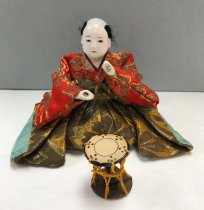
-
Japanese Girls Day Doll, c. 1920s - Doll, Decorative
Japanese Girls Day Doll, c. 1920s. Small Japanese figurine used in celebration of Girls's Day. The head, facial features, and hands are painted very pale fleshtones. Black fiber used for hair, may be dyed wool. Hair is styled with two side-locks, tied with white silk string, and a recessed or shaved hairline. Figure wears a robe (kimono) with stuffed sleeves, woven in large floral pattern brocade, in taupe, gold and teal. The sleeves are st...
Record Type: Object
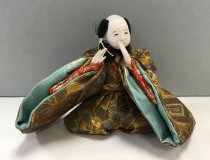
-
Japanese Imari Plate (A) and Stand (B), c. 1950s - Plate, Decorative
Japanese Imari Plate (A) and Stand (B), c. 1950s. Plate is blue, red, pink, and beige. The plate has seven sections on it, with the center depicting flowers and branches in blue, red, and pink with a white background. Three of the sections around the center depict a small, light blue flower over a red and blue background with a gold leaf overlay; the three others depict a small, light blue bird perched on a branch with gates and red, pink, and wh...
Record Type: Object
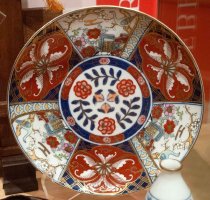
-
Japanese Kimono, c . 1920s - Kimono
Japanese Kimono, c . 1920s. Off-white silk floral damask, with silk-screened geometric design. Six Japanese characters printed in red with black outline, down front of collar, which translate to "Happy Harvest". Delicate cherry blossom print in pink and green, above bold multi-color print of interlocking circles and lines in pink, blue, green and orange. Interlocking circles and lines are also found across back of shoulders. Black border with ...
Record Type: Object
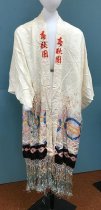
-
Japanese Koto Bridge, c. mid 1950s - Component, Musical Instrument
Japanese Koto (harp) bridge, c. mid 1950s, plastic, ivory colored, shaped like an arch with a pointed end that has a notch on the top where the strings lay.
Record Type: Object
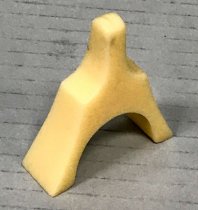
-
Japanese Koto (Harp) Accessory Box with Lid, c. mid 1950s. - Box, Storage
Japanese Koto (Harp) Accessory Box with Lid, c. mid 1950s. Rectangular, unfinished light wood. The lid is detached from the box.
Record Type: Object
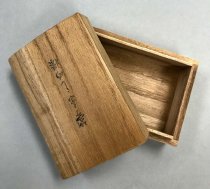
-
Japanese Koto (Harp) Pads, c. mid 1950s. - Component, Musical Instrument
Japanese Koto (Harp) Pads, c. mid 1950s. Four rectangular, cream-colored, leather-like pads for Koto tuning machines. Each one has a hole in the middle and a tiny hole on the tip. One side is slightly smoother than the other.
Record Type: Object
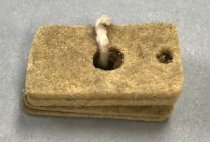
-
Japanese Koto (Harp) Tuning Wrench, c. mid 1950s. - Wrench, Key
Japanese Koto (Harp) Tuning Wrench, c. mid 1950s. Gold-colored metal wrench, shaped like a key, with two holes on the bow, and a square hole on the bottom of its pipe-like body that would attach to tuning pins on a Koto.
Record Type: Object
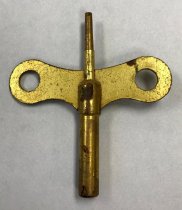
-
Japanese Koto (Harp) Tuning Wrench, c. mid 1950s. - Wrench, Key
Japanese Koto (Harp) Tuning Wrench, c. mid 1950s. Gold-colored metal wrench, shaped like a key, with two holes on the bow, a pipe-like body that is thiner above the bow and thicker below it. It has a square hole on the bottom of both tips that would attach to tuning pins on a Koto.
Record Type: Object
